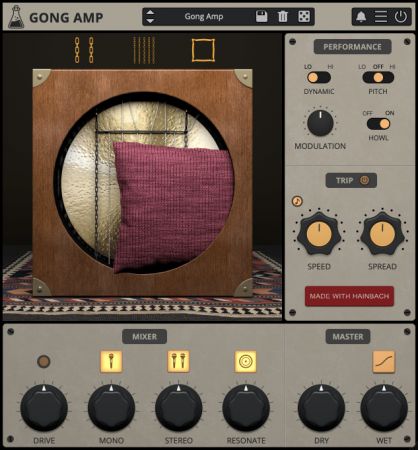
Gong Amp 将令人兴奋的实验放大器从电子音乐的起源带到了今天的插件世界。
1932 年,莫里斯·马特诺 (Maurice Martenot) 正在寻找一种方法,让他开创性的原始合成器“Ondes”在当时的号角和扬声器无法保存的声音中听得见。他开发了一套“扩散器”,“Métallique”就是其中之一。 Martenot 在放大器电路后面放置了一个音簧,而不是纸盆或喇叭。这个看似简单的想法产生了共鸣和精彩的泛音,至今仍让观众兴奋不已。
2011 年,法国公司 Eowave 从 Martenot 的发明中汲取灵感,制作了自己的版本 Resonator Metallik。当我们听到我们的朋友柏林作曲家 Hainbach 对这款罕见且已停产的放大器所做的事情时,我们知道这种声音需要提供给超过少数人。因此,我们制作了 Gong Amp,这是自 Motors and Wires 以来我们与 Hainbach 的第三次合作。
使用卷积处理、物理建模和反馈系统的复杂混合,我们创造了一种乐器,它忠实于原作的响应能力,甚至在声音设计的可能性方面超越了它。
Gong Amp takes an exciting experimental amplifier from the beginnings of electronic music to the plugin world of today.
In 1932, Maurice Martenot was looking for a way to make his groundbreaking proto-synthesizer “Ondes” audible beyond what could be archived with the horns and loudspeakers of the time. He developed a set of “diffuseurs”, of which the “Métallique” was one. Instead of a paper cone or horn, Martenot put a gong behind the amplifier circuitry. This seemingly simple idea resulted in resonances and brilliant overtones that excite audiences to this day.
In 2011, the French company Eowave took inspiration from Martenot’s invention and made their own version, the Resonator Metallik. When we heard what our friend, Berlin composer Hainbach, did with this rare and discontinued amplifier, we knew this sound needed to be available to more than a select few. So we made Gong Amp, our third collaboration with Hainbach since Motors and Wires.
Using a complex mixture of convolution processing, physical modeling, and feedback systems, we created an instrument that is true to the responsiveness of the original and even transcends it in terms of sound design possibilities.
Whats New
Updates: official site does not provide any info about changes in this version.
